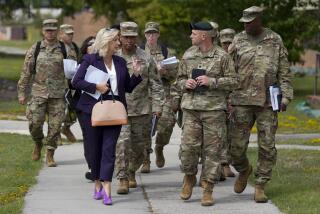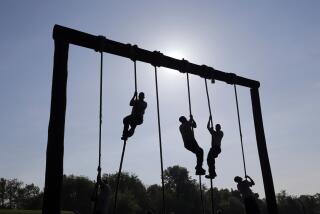U.S. Army Has Plenty to Offer Youth
- Share via
In each year of the the coming decade, the U.S. Army will need to recruit about 85,000 active duty soldiers and 100,000 citizen soldiers for the Army Reserve and National Guard. The Army must recruit another 10,000 young men and women a year for West Point, ROTC and Officer Candidate School, our active and reserve officer training programs.
It should not be hard to find great young Americans to accept the best training and education experience in the world, one that comes with the deep satisfaction of knowing you have served your country and helped keep it strong, but it is.
Many young men and women in the prime recruitment market of 17-to-24-year-olds don’t meet the military’s high educational, moral and physical standards. Drug use, an arrest record, gang tattoos, low mental ability and failure to complete high school without successfully completing additional education or training are virtual bars to enlistment. Many of those who do qualify are college-bound youth, who are not challenged to consider seriously their responsibility to serve our country or the benefits of military service.
Today, the Army will sponsor a summit in Los Angeles to communicate more broadly the great opportunities that are available. We will especially address the Army’s interest in making those opportunities better known to America’s fast-growing Latino community. Despite a great record of honorable and highly decorated service by Latinos in our nation’s conflicts, they are underrepresented in all services of the U.S. armed forces. Our nation’s ability to fill the ranks in the future will depend on our ability to successfully recruit more Latinos, starting now.
Fortunately, Latinos--as represented by Army Staff Sgt. Andrew Ramirez, the former Serbian POW from East Los Angeles who will join us--as a group, have the highest youth interest in military service. Latinos enjoy the highest reenlistment rates and experience the lowest attrition rate among all soldiers; and many choose to serve in the hard-to-fill combat arms units.
Why are Latinos underrepresented in the armed forces, given such a predisposition to serve? Because of an unacceptably low high school graduation rate, which for many is a bar to entry. Low educational achievement among Latinos is a serious national problem that the Army is not waiting for others to address.
Our initiatives to improve recruitment among all groups, including Latinos, encompass:
* Communicating a strong “stay in school” message for at-risk youth through an extensive Army-sponsored advertising campaign;
* Expanding the number of Junior ROTC programs in America’s high schools to teach active citizenship and to help familiarize more families, youth, faculty and communities with military service;
* Assisting older, motivated and able high school dropouts who score in the top half of the armed forces mental aptitude test and meet our high moral standards to gain the educational credentials they need to meet our enlistment criteria. We are proposing a new pilot program to help several thousand such recruits each year obtain a high school equivalency degree by sponsoring their participation in a GED program. This initiative may be particularly helpful to recruiting Latinos, who drop out earlier and are less likely to earn alternative degrees, but who have strong labor force participation rates and higher than average military interest. But it is not limited to Latinos; indeed, most of the Army’s GED holders are not minorities;
* Dispelling the idea that you must choose between military service and college. We will promote our College First Enlistment Option and our Learn While you Serve Tuition Assistance Programs and expand tuition-free distance learning options for soldiers. The Army’s best-kept secret is that virtually every soldier is a student working on an undergraduate or graduate degree, and much of the training can be credited toward a college degree.
These initiatives will help meet current recruiting challenges. Over the long run, however, the nation’s military strength at home and abroad, our moral leadership in the world and our ability to safeguard the freedoms that more than 1 million Americans have laid down their lives to preserve will come from instilling in all our youth the belief that military service is a precious obligation of citizenship.


